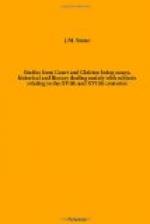Of the three others we have ample details; their hoards have been thoroughly ransacked, and there are scarcely any surprises for the student. We can, without much trouble lay our hands on any fact, beauty, or excellence to be found in them, for there are hardly any hidden gems. But with the Royal library it is different. Each student is his own pioneer, and must make voyages of discovery if he would know something of the riches which it contains.
Its history is scarcely more complete than its catalogue; although the nucleus of the collection must be almost coeval with the monarchy. Before the reign of James I., however, there were no records except the strangely anomalous ones contained in the Privy Purse Expenses, and in the Wardrobe and Household Accounts of the various English kings who have added to the library. It is curious to light, among the sums disbursed for such items as feather-beds and four-post bedsteads, on the price paid for a rare manuscript, or for the binding of a choice codex. Queen Elizabeth’s “Keeper of the Books” was also “Court Distiller of Odoriferous Herbs,” and received a better salary as perfumer than as librarian. But in times when books were more costly, the office of custodian was considered an honourable one, and a Close Roll of the year 1252 makes mention of the Custos librorum Regis.
Impossible though it be to fix the exact date or even reign when the English kings began to collect books, we shall not be wrong if we infer that the Royal library had already a very real existence in the reign of Henry ii., when a great literary revival took place. Although the movement originated in the cloister, the court followed in its wake, and William of Malmesbury had his secular counterpart in Alfred of Beverley. A favourite of the king’s, Walter de Map, who had been a student in Paris, and Gerald de Barri (Giraldus Cambrensis) divided the honours between courtly and popular themes, while a number of poets and romanticists sprang up and wove fantastic myths and legends out of such material as the Crusades, the Arthurian traditions, and the feats of Charlemagne. King John, with scarcely a quality which men cared to praise, was, strangely enough, fond of books and of scholars. A taste for learning was gradually leavening the barbarous Normanic lump, spreading downwards from monarch to people. Two years before John’s death Roger Bacon was born, whose opus Majus embraced every branch of science, and whose life is the whole intellectual life of the thirteenth century. Matthew Paris, the last of the great monastic historians, was the intimate friend of Henry iii., who delighted in his scholarship, and loved to visit him in the scriptorium at St. Alban’s where he himself contributed to the famous chronicle, which would alone have sufficed to make the reputation of the learned Benedictine. Thus, indirectly, we are led to the Royal library.
In 1250, a French book is mentioned in a State Paper as belonging to the king, but being actually in the keeping of the Knights Templars, who are commanded to hand it over to an officer of the Wardrobe, with the apparent object that the king’s painters might copy from it when painting a room called the Antioch Chamber.




